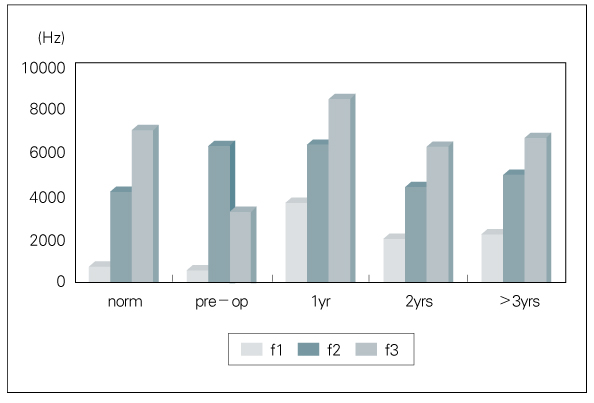J Korean Med Assoc.
2004 Dec;47(12):1214-1222. 10.5124/jkma.2004.47.12.1214.
Aural Rehabilitation and Development of Speech Perception Skills in Young Children with Profoundly Hearing Impairment
- Affiliations
-
- 1Department of Otolaryngology, Kyungbuk National University School of Medicine, Korea.
- 2Section of Speech Language Pathology, Kyungbuk National University Hospital, Korea.
- KMID: 2065217
- DOI: http://doi.org/10.5124/jkma.2004.47.12.1214
Abstract
- Rehabilitation of young children with hearing impairment can be defined as a teaching/learning process where the role of the clinician is to facilitate the acquisition of listening, speech and language in a normal developmental order. The young children with hearing impairment are helped by hearing aids and cochlear implants to learn language. Auditory (re)habilitation in young children with hearing impairment is to acquire auditory skills at four stages : sound detection, sound identification through imitation, sound discrimination, and comprehension. Without appropriate auditory training and early intervention, children with hearing impairment cannot develop spoken language. Speech acquisition is a perceptual as well as an oral process. To maximize the speech acquisition in children with hearing impairment, indepth understanding of the characteristics of the children, the parents' motivation and cooperation, a well-designed educational program, and the high competence of the health care professionals are important. Therefore, listening is not an isolated skill, and the auditory development in children with hearing impairment should be achieved in a comprehensive approach. Young children with hearing impairment need supports and guidance from health care professionals whose holistic approach balances auditory learning with the parallel development of the children's other learning processes.
MeSH Terms
Figure
Reference
-
8. Blamey PJ, Sarant JZ, Paatsch LE, Barry JG, Bow CP, Rattigan K, et al. Relationships Among Speech Perception, Production, Language, Hearing Loss, and Age in Children With Impaired Hearing. J Speech Lang Hear Res. 2001. 44:264–283.
Article9. David J. Emergence of a Vowel System in a Young Cochlear Implant Recipient. J Speech Lang Hear Res. 2001. 44:803–814.
Article10. Dettman SJ, Barker EJ, Dawson PW, Blamey PJ, Clark GM. Clark GM, Cowan RSC, editors. Vowel imitation task : results over for 28 cochlear implant children under the age of eight years. International cochlear implant symposium in Melbourne 1994. Annals of Otology, Rhinology and Laryngology. 1995. 321–324.11. Donoghue GH, Nikolopoulos SM, Archbold MT. Cochlear implants in young children and speech intelligibility. Ear & Hearing. 1999. 20:419–425.12. Geers AE, Moog JS. Speech perception and production skills of student with impaired hearing from oral and total communication education settings. JSHR. 1992. 35:1384–1394.13. KirK KI, Pisoni MJ. Lexical effects on spoken word recognition by pediatric cochlear implant users. Ear & Hearing. 1995. 16:470–481.
Article14. Matthies ML, Svirsky M. Acoustic and articulatory measures of sibilant production with and without auditory feedback from a cochlear implant. JSHR. 1996. 39:936–947.
Article15. Moog JS, Bildenstein J, Davidson L. Speech perception Instructional Curriculum and Evaluation(SPICE). 1995. St Louis: Central Institute for the Deaf;221.16. Moog JS, Geers AE. Achieving auditory speech perception skills in profoundly deaf children with hearing aid and cochlear implants. 1998. Whurr Publishers: Cochlear implant rehabilitation in children and adult;166–178.17. Raymond H. Hull, Aural rehabilitation. 1982. 2nd ed. San Diego: Singular Publishing Group;88–117.18. Robinshaw H, Evans R. Assessing the Acquisition of the Auditory, Communicative and Linguistic Skills of a Congenitally Deaf Infant Pre-and Post-Cochlear Implications. Early child development and care. 1996. 117:77–98.
Article19. Romanik S. Auditory skill programme for students with hearing impairment. Special Education and Focus Programmes Division, Nsw Department of School Education, Australia. 1998. 1–17.20. Tomblin JB, Spencer L, Flock S, Tyler R, Gantz B. Comparison of Language Achievement in Children With Cochlear Implants and Children Using Hearing Aids. J Speech Lang Hear Res. 1999. 42:497–512.
Article21. Tye-Murray N, Kirk KI. Vowel and Diphthong production by young users of cochlear implant and the relationship between the phonetic level evaluation and spontaneous speech. J Speech Lang Hear Res. 1993. 36:488–513.
Article
- Full Text Links
- Actions
-
Cited
- CITED
-
- Close
- Share
- Similar articles
-
- Evaluation of Speech Perception Abilities in Children with Cochlear Implants
- Proximity Analysis of Web-Based Auditory Training Programs: Toward Listening and Customized Learning Exercises for Aural Rehabilitation
- A Case of the Vibrant Soundbridge Implantation to Unilateral Congenital Aural Atresia
- Effects of Ageing and Hearing Thresholds on Speech Perception in Quiet and in Noise Perceived in Different Locations
- Early Detection of Childhood Hearing Impairment




